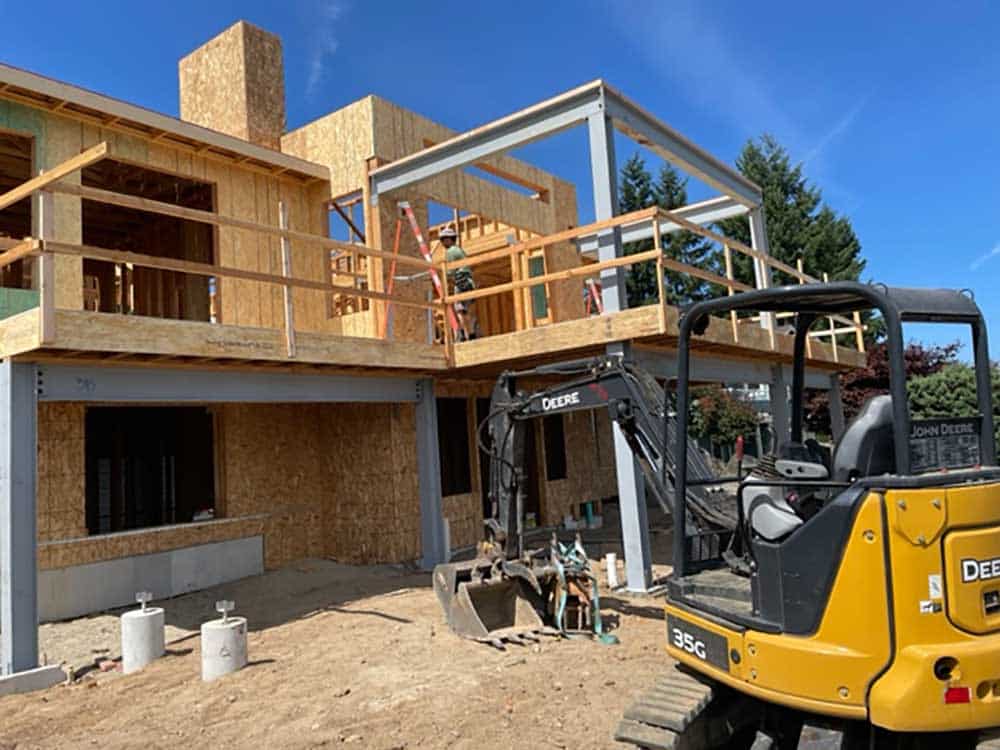Business Columns Community
In the Margins: Not your father’s real estate market, nor your mother’s
Nearly 40 years ago, my wife and I purchased our first home. For what seemed like a staggering sum of $75,850 ($221,000 in today’s dollars), we moved into a 1,350 square-foot, three-bedroom home in a small subdivision just north of the Harbor.
Community Sponsor
Community stories are made possible in part by Peninsula Light Co, a proud sponsor of Gig Harbor Now.
We vacuumed our sofa cushions for the down-payment and borrowed the balance at a gut-wrenching 13.4% interest rate. We also got a dog to help us stop thinking about the mortgage.
Fast forward to the twisted 2020s, when both our adult children and their spouses recently climbed into the cage fight called the housing market. Despite bidding wars with cash-carrying buyers from the Bay Area, they managed to purchase their first homes in the suburbs of Seattle and Portland, respectively. Their down-payments were larger than the full price of our first home, but their interest rates in the 3% range were something we couldn’t even hallucinate about in 1984.
In real estate, trends last for about 10 minutes. Just look at those designer sofa cushions you bought on Target.com during the COVID retreat.

Local family-owned builders were once the mainstay of Gig Harbor real estate. Today they rely on custom work and remodels like this home being built on Soundview Drive.
Meet the experts
To examine the seismic shifts of Gig Harbor’s landscape, I scanned my iPhone contacts to find a pair of lifelong real estate natives and one relative newcomer to the profession. I asked them to share perspectives on this place we call home.
John Holmaas entered the land development game back in the mid-’60s, when The Beatles were playing concerts at Seattle Center. After graduating from University of Puget Sound with a business degree, he often teamed up with local developers like Jim Tallman and Walt Smith. His father ran a boathouse of wooden rowboats in Tacoma.
“Fishing was for food, not just sport,” he said.
Over the years, he and his wife Carole have made the Energizer Bunny look lethargic. They led creation of the Gig Harbor Lighthouse and helped establish the Harbor History Museum. They built careers by transforming dirt into salable development and livable neighborhoods.
Their list of completed work includes at more than 48 residential and commercial projects, everything from Woodcrest (Peacock Hill) and Trillium Park (near Canterwood) to that shiny new Elephant Car Wash (adjacent to The Inn at Gig Harbor).
“I’m like a dog catcher,” said John. “I’ll take all breeds … I like working with the dirt, but I don’t want to show property anymore.” Smart guy, because competing with his wife for home sales would be a futile venture.
Sunny afternoon observations
Dave Morris, another local lifer in real estate, entered the market in the mid-’70s. He followed the footsteps of his father, Tom Morris Sr., at a company called Purdy Realty. After graduating from UW and serving a couple years in the Army, mostly in Korea, Dave saw local career choices consisted of logging, commercial fishing, or farming.
He chose real estate, with a focus on larger lots, short plats, and property sales. He grew the business with an investor mindset and served as broker, allowing him to oversee more than 10,000 real estate transactions over time. At peak, his brokerage encompassed 115 agents.
“I started by getting in the habit of buying and selling land — two or three pieces of property a year,” said Morris.
He also enjoyed mentoring incoming real estate agents. While the ink was drying on his college diploma, Brian Taylor came to Morris as a free agent, entering the business in 2007 under the Keller Williams banner. He’s now one of 16 agents with Sievers Real Estate. He focuses on homes and property in the Gig Harbor, Tacoma, and Port Orchard markets.
By spending a couple sunny afternoons on decks overlooking the Harbor, I compiled a few hip-pocket market observations from these real estate pundits. My findings, together with $40, might be valuable enough to fund more of those Target sofa cushions:
Large lots are out, and so is yard work
Many buyers in the past yearned for spacious lots, big yards, and grand gardens. Today, more buyers are trading in the lawnmower for an air fryer and maximized square footage.
“They don’t want to miss any opportunity in life because they have to stay home and work on the yard,” said Morris.
Newer homeowners are less interested in landscaping and more interested in Hulu, Netflix, or a week of Airbnb in Scottsdale. It’s a sensible tradeoff if you don’t mind the proximity of your neighbor’s 50-inch TV with surround sound.
Development density is like broccoli — healthy, but do we love it?
Planners and taxing entities embrace density. Urban Planning 101 teaches us that public services can be provided at higher levels and with greater efficiency if we avoid 30-mile school bus routes and a sprawl of two-acre lots.
Today, it’s gratifying to see kids riding bikes and walking to school in the Gig Harbor North community. That was impossible for my kids in the 1990s. Coffee shops and grocery stores are nearby. Pedestrians have come out of extinction like the resurgence of the gray wolf in the Cascades. And our roulette-like traffic circles provide plenty of motorized entertainment/rage.
“City zoning regs and the urban core forced the mice into the cheese,” noted Morris.
Alas, the tradeoff is that congestion and crowding once reserved for the urban core is now a familiar sensation on Harborview Drive and Highway 16.
Corporate capital and regulatory costs stifled a cottage industry
Small home builders and developers — once the staple of local development — have gone the way of the Pontiac station wagon. Mortgage lenders prefer the broader risk profile of scaled-up corporations that commit to large swaths of home development across diverse regional markets.
“The small developer today does not have much of a chance,” said Holmaas. “Most banks won’t even lend (on land) unless you have water and septic approvals in hand.”
Higher costs of permits and more demanding land-use requirements — sometimes necessary to fund infrastructure — mean more up-front capital (and patience) is needed before a foundation ever gets poured. Holmaas said local family-owned builders used to have a decent year by completing two to five homes per year. If they survive today, it’s on a diet of custom work and remodeling. One of them also rescued me in the plumbing aisle at Home Depot last weekend.
Everyone’s an agent, until they aren’t
Thanks to HGTV’s Chip and Joanna Gaines and the COVID migration from downtowns to smaller towns, many entrepreneurs saw surging real estate sales as an opportunistic gig. Being a licensed agent gained broad appeal, and sales commissions flowed in like an incoming tide at the Narrows Bridge. But tides also ebb.
“Suddenly everyone was in real estate. It was a buying frenzy, and frankly it started to feel a little easy. A lot of people took it on as a side job,” said Taylor. “Now it’s back to being more normal. It’s a job you have to work at. Deals don’t fall into your lap. A lot of those agents have left the business now.”
DIY is trending down among younger home shoppers
Fewer new homeowners are excited about the prospects of do-it-yourself projects. Taylor said many of today’s new buyers tend to shy away from fixer-uppers, preferring turn-key homes if they can find them. Despite You Tube videos on how to install a kitchen sink, many buyers would prefer to avoid whatever lurks beneath those cabinets.
Appreciation will persist, but it won’t send the kids to college
Looking forward in the real estate market is like trying to figure out how much extra time will be added to end of a FIFA soccer match. But my deck-chair pundits did offer several clear outlooks:
- Industry costs will continue to climb despite well-intentioned pledges involving “affordable housing”;
- Buyer demand will take a cold shower due to normalized (higher) interest rates;
- Never fear, the bravest buyers will still find their way back to the party even if it takes them longer to arrive;
- Supply of salable homes and buildable land will not immediately catch up to demand because 1) costs of approvals have soared, 2) site development takes 12 to 18 months, construction is another 6 to 9 months, and 3) existing owners will be reluctant to exit bargain interest rates in order to move into a 7 percent rate environment;
- Most local homes will be purchased in higher-density subdivisions with yards smaller than the first tee box at Madrona Links;
- Real estate agents should not expect walk-in customers unless they are located next to a bagel shop or a craft brewery;
- Home values will still appreciate but more modestly, so don’t believe all the stories you might hear on the deck at the Tides Tavern;
- The windfall of repeatedly refinancing to lower interest rates should not be part of anyone’s retirement or college-funding plan.
In the end, real estate development is an often risky, sometimes rewarding, always expensive, long-term game. Anticipate high costs, then multiply. My advisory panelists recall painful losses with as much detail as their wins.
So, as the saying goes, if you can’t stand the heat in the kitchen, go shopping for designer sofa cushions at Target. I’ll see you there.


